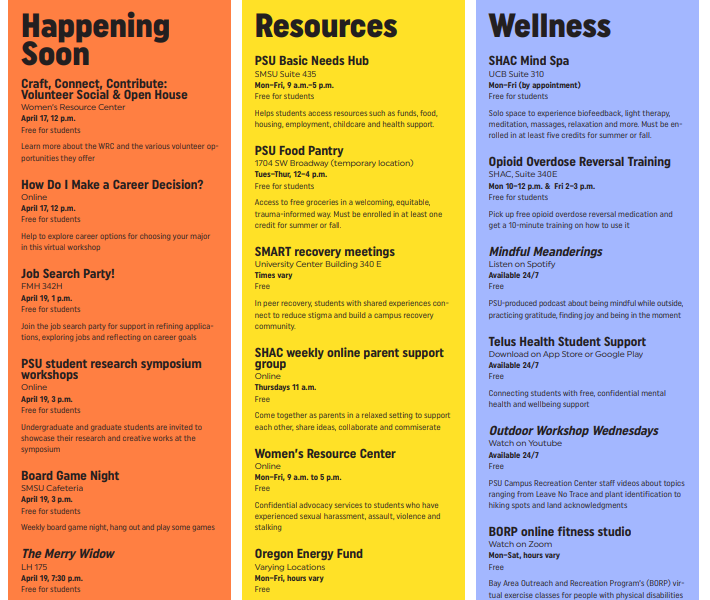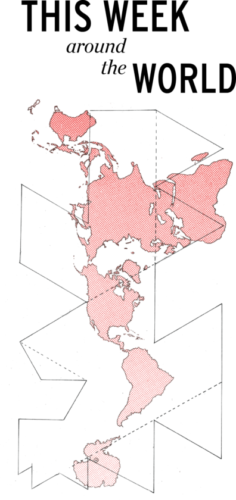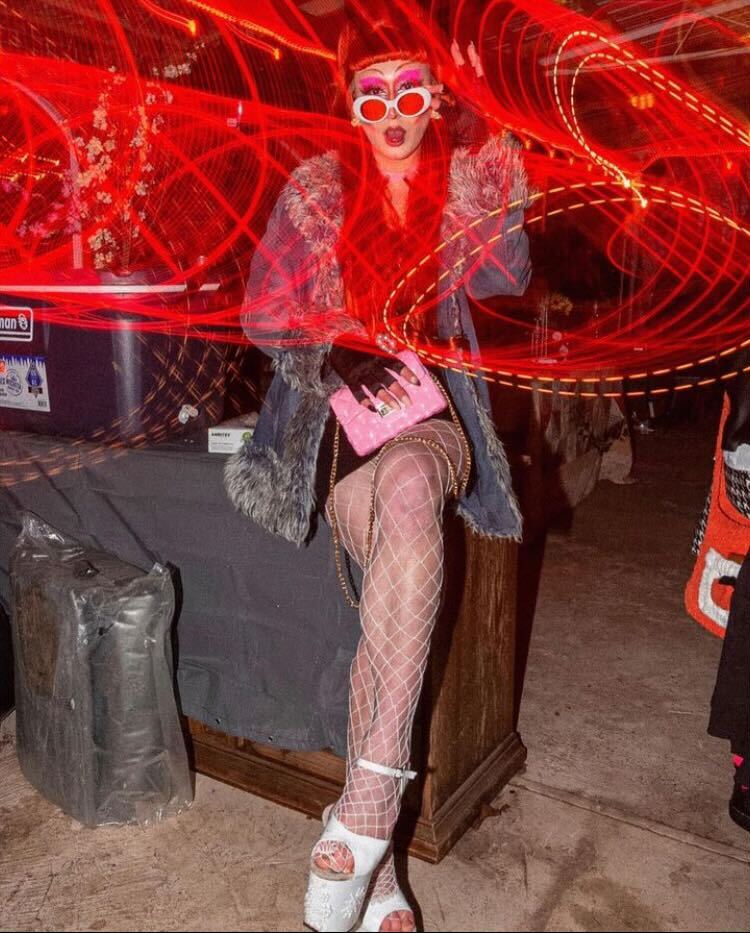The Portland State Cuba Solidarity Club was formed by PSU students in the fall of 2022. Their goal was to show solidarity with Cuba by spreading awareness of common biases and misconceptions and to actively oppose the economic embargo that the United States imposed on the country in the early 1960s.
They started small, recruiting students at table events and slowly working through the processes and procedures required of new student organizations. Jillian Goldstein—at the time a freshman in her first term at PSU—was recruited at one of those table events. In the middle of an early October day, PSU Cuba Solidarity held their very first meeting. Goldstein attended that first meeting and has stuck with the club since.
That was well over a year ago. Today, the club is fully recognized as an official Student Activities and Leadership Programs organization, and Goldstein now holds the title of Club President.
“I was just looking for ways to get more involved on campus,” Goldstein said. “I came to the meeting and it seemed like this was a really progressive group. These people actually care and want to make a difference.”
The club aims to achieve two principal goals by meeting weekly and hosting and attending events. Its primary mission—rooted in a combination of education and opposition—is better understood within the historical context.
A brief history of Cuba-U.S. relations
According to Britannica Encyclopedia, Indigenous peoples lived autonomously on the tropical island of Cuba for thousands of years before Spain arrived in 1492. This period of Spanish colonization would last until the Spanish-American War at the turn of the nineteenth century.
According to the U.S. Library of Congress, in 1898 the USS Maine—a U.S. naval ship—sank near Havana Harbor, the main port of Cuba. Sensational journalism at the time suggested that Spain was responsible for the explosion which doomed the ship, ultimately leading to the Spanish-American War. After the Spanish-American War, the U.S. briefly occupied the island until Cuba became independent in 1902.
Pedro Ferbel-Azcarate is an interdisciplinary scholar and assistant professor of archaeology at PSU. Among his specialties are the studies of national identities and cultural survival with a primary focus on the Spanish-speaking Caribbean. He teaches several courses on Cuba and is currently creating a study abroad program on the eastern side of the nation.
Ferbel-Azcarate suggested that the Monroe Doctrine—and the actions and decrees that resulted afterward—were pivotal turning points which would determine the trajectory of Cuban-U.S. foreign policy. The Monroe Doctrine is an 1823 message from Former President James Monroe which called for the cessation of European activity that interfered with affairs in the western hemisphere.
“We’ve got to look at the Monroe Doctrine,” Ferbel-Azcarate said. “I think that is often the place where historians will suggest the relationships between the United States and Cuba really began to be identified.”
The U.S. has a long history of military presence in Cuba. According to the U.S. Library of Congress, the U.S. has wielded control over Guantanamo Bay since 1903, making it the oldest overseas U.S. naval base. In addition, a complex system of imperial U.S. commerce centered around the Caribbean in the nineteenth century has cemented Cuba as a fundamental location for U.S. foreign activity.
From 1953−1959, the Cuban Revolution waged on. The 26th of July Movement, a revolutionary organization headed by Fidel Castro, would lead the battle against the U.S.-backed Cuban government. According to the BBC, the country had installed a new government system led by Castro by 1959. Cuba would come to ally with the Soviet Union and declare itself a communist country.
According to Ferbel-Azcarate, the governments in Cuba prior to the Cuban Revolution are referred to as handpicked regimes influenced by U.S. interests. This departure from U.S. influence, compounded by the political decisions of the new government, created a new set of challenges for the U.S. Increasing tensions, this then led to the infamous Cuban Missile Crisis, nearly resulting in Cuba’s nuclear annihilation.
The embargo
In response to Cuba’s new government system established in 1959, Former President John F. Kennedy enacted a historic economic embargo against Cuba. In short, this set of policies barred U.S. businesses from engaging in trade with Cuba, meaning no U.S. goods could be shipped to Cuba. The embargo is still in effect today.
Dr. Kevin Kecskes—Department Chair and Professor of Public Administration in the Mark O. Hatfield School of Government at PSU—spoke about the embargo. “It’s an immoral act,” Kecskes said. “It’s an institutionalized, national, politically-unethical act from our government that our citizens put up with. It is wrong, what we do. It’s wrong.” Like Ferbel-Azcarate, Kecskes teaches courses focused on Cuba here at PSU, one of which involves a study abroad program on the island.
Cubans refer to the U.S. embargo against Cuba as the blockade, or “el bloqueo” in Spanish. “[The U.S.] put [Cubans] on a terrorist list,” Kecskes said. “They’re not terrorists. We are punishing them for running the country the way they see fit… We have tightened the noose around that poor country for 60 plus years.”
According to Kecskes, the U.S. embargo against Cuba continues to have a massive impact on the Cuban people’s quality of life in many ways. Kecskes explains that all sorts of modern necessities are incredibly scarce, ranging from toothpaste to screws. Contraceptive shortages are an immense issue, as are finding parts to maintain machines such as computers or automobiles.
The barriers faced by Cuban people to access basic necessities, medicines, health care services and food products are a direct result of the blockade. These issues have shaped the reality of Cuban life for the past 65 years. “It’s like the clouds in Oregon—so omnipresent that we don’t even see them anymore,” Kecskes said.
Due to these economic policies, travel to Cuba from the U.S. has also been significantly limited. U.S. citizens are barred from traveling straight to the country without obtaining an entry visa, which is not a Cuban-mandated requirement but a U.S. one.
“They have these 12 categories that enable U.S. citizens to travel to Cuba, but they’re very tightly defined,” Kecskes said. “One of those 12 categories is [you must be part of] a legitimate, educational study abroad program.” This is what allows Kecskes and his students to travel to Cuba.
U.S. misconceptions of Cuba
Kecskes comes from a blue-collar background and he’ll tell you what it’s like to float between that world and the world of academia. On the weekends, he plays hockey with friends. When he first brought up his trips to Cuba with these friends, they were shocked to hear he had visited.
These days—at least from a U.S. perspective—Cuba is often seen as a crime-ridden, dangerous country. Kecskes recounts how images of gang violence, prostitution, communism, rum and cigars are the most common imagery which comes to the mind of many U.S. residents. However, he finds this couldn’t be farther from reality.
“Cuba is one of the safest places I’ve ever been in,” Kecskes said. “I’ve been there six times. It’s safe.” These days, he most often visits with students in his program.
Among those students is PSU graduate student Alyssa Tuss. In Dec. 2023, she attended the Cuba study abroad program led by Kecskes. After the trip, she wrote a research paper titled “Cuban Perspectives of US-Cuba Relations.”
When Tuss spoke about her experiences on the island, she made sure to relay how different things are there compared to the U.S. perspective.
“There were 11 of us graduate students from quite a variety of programs,” Tuss said. “We met with locals. We did interviews. We had lectures. We did quite a variety of activities. We did roundtables and met with everyone from researchers and scientists to entrepreneurs, all to get a better sense of what’s going on in Cuba.”
One of the biggest points which Tuss wished to drive home is that the Cuban perception of the U.S. is very different than the reverse.
According to Tuss, it is much more common to find Cubans who may criticize the U.S. government but do not consider themselves to be anti-American. Tuss explained that the use of language in discussions of Cuba is critical, addressing the importance of distinguishing criticisms of the Cuban government from anti-Cuban sentiments.
“I was talking to a colleague whose family is Cuban,” Tuss said, “His grandparents came to the U.S. [from Cuba]… The language they used was not anti-Cuban, but anti-Castro or anti-regime.”
Both Tuss and Kecskes agreed that, when visiting Cuba, the locals were warm and welcoming.
PSU Cuba Solidarity
Misconceptions about the Cuban people and ignorance about the U.S. embargo against Cuba are issues that PSU Cuba Solidarity hopes to bring to light at the campus level.
“There’s two sides to every story,” Goldstein said. “A lot of the misconceptions about Cuba are a result of the blockade but are not attributed to that. Shortages of medical supplies, for example, have been due to the blockade, but a lot of media sources here will not give out that information.”
Current Cuban Ambassador Lianys Torres Rivera, the first woman appointed to the position in history, was scheduled to visit PSU at the request of PSU Cuba Solidarity. However, the event was canceled due to an emergency, the nature of which remains a mystery. Goldstein said getting the ambassador to come to the PSU campus is a major goal of the club, with the hopes they’ll be able to make an April meeting work.
Another long-term goal of the club is to ensure a steady flow of new members and maintain high membership numbers.
“We have like six or seven people that come to the meetings every week,” Goldstein said. “Honestly, everyone in the club is super active… Everyone is taking on multiple responsibilities. Obviously, if we had more people, then it’d be distributed more evenly.”
Despite their difficulty recruiting members, PSU faculty like Ferbel-Azcarate are happy with the club’s progress.
“I think that’s the real story,” said Ferbel-Azcarate while reflecting on PSU Cuba Solidarity. “I’m just the professor who teaches the classes, but the students really took that extra step to create an event… When students really step up like that, I think that’s what education is all about.”






